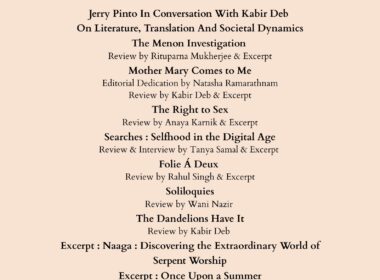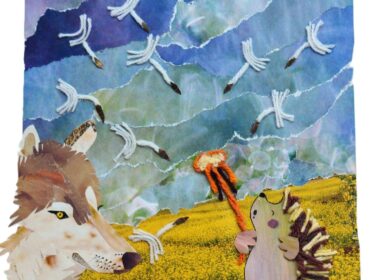The clerics said all graven images must be destroyed. Despite many strident voices in opposition, even from others who shared their faith, the clerics would not be swayed. The two great statues must come down. They were the work of infidels who, though a thousand years removed, did not believe in the Creator and his Messenger. In this land, the clerics decreed, only those works inspired by the one and only Creator – the All-Knowing and All-Seeing one – would be preserved.
Did not their holy book command as much? And were not these commandments the literal word of God? Did not God himself condemn as heretics those who would dare to depict His image? Whether it be a child’s scrawl on a piece of parchment or a monumental carving in granite, all such depictions were sacrilegious and their creators subject to the harshest penalties under the law. The child must be whipped and the sculptor stoned. Elsewhere, the infidels were free to mock their own Gods as wantonly as they pleased. As long as they did not set foot in the Land of the Faithful.
Of this the Faithful had little to fear, for theirs was a truly forbidding land. The mountains to the north were rough and barren, the deserts in the south hot and dry, and the valleys in the west unproductive. Only the hardiest of souls could endure the oppressive summer heat and the bitter winter cold. And so, the people of this land became renowned for their fortitude in the face of adversity. They were said to have a will of iron. Those foolish enough to challenge them in battle were certain to pay a dear price.
In this point in their history fate seemed especially unkind, and the hearts of the Faithful had grown as hard as their will. Two decades of war with the northern enemy had left their land in ruins. The cities were rubble, the countryside a chaotic patchwork of gutted, impassable roads. The fruits of the orchard and the grains of the field could not reach the hands of the hungry. Supplies of drinking water and heating fuel were dangerously depleted. The spring of the year was nigh, yet no one rejoiced. Instead, charnel grounds were prepared for those who did not survive the winter.
For many of those who lived through war and the elements, yet another task remained. Every young man who could still walk, every old man who could still stand, must journey to the site of the larger of the two idols and observe its destruction. No women were summoned, because they were deemed to be subservient to men. They were less intelligent, less disciplined, less resolute – and thus less faithful. And so, like good soldiers of God, all of the able-bodied men obeyed their leaders and set out on this odd pilgrimage. Few of these faceless men knew anything about the ancient people who had fashioned the monuments, only that they were distant ancestors of the Roof-Dwellers to the east. And many of these high-mountain folk – whose land known as “The Roof of the World” – still followed the teachings handed down ages ago by the one in stone. They did not believe in the All-Knowing and All-Seeing One. And that was enough.
*
While the Faithful prepared for destruction, their Eastern neighbors prepared for celebration. Here, the appearance of the first full moon of spring marked the new year, and four days of prayer, chanting, and alms giving now commenced. Outside the gates of their temples and monasteries, the air resounded with music and gaiety. A large city in the south was the center of culture and commerce, a venerated place that sprang to life on this auspicious occasion. Even their overlords could not deny the Roof-Dwellers their rightful time in the sun.
It had been four decades since the overlords came, out of the great river valleys to the east. Small in stature, they were a people so numerous that they could overrun any of their neighbors virtually at will. For this reason they were known as the Eastern Hordes. Forty and three years earlier, their leaders observed that there lived, in the high ranges of their western border, a peaceable people of faith with no real means of defense, save for the vast mountain stronghold that surrounded them. The Eastern Hordes had no faith of their own, only a set of beliefs and a means of distributing resources which they felt made them superior to all others. So they massed at the Roof-Dwellers’ portal and proceeded to occupy their land.
As any invading force does to its subjects, the army of the Eastern Hordes took from the Roof-Dwellers all that was dear to them. They reaped a million lives, razed a thousand temples, revoked a hundred freedoms. And now, precious little remained of the Roof-Dwellers’ vibrant and colorful life. The invaders had populated the land with so many of their own that the Roof-Dwellers were in danger of becoming a minority presence in their own home. And yet, a vestige of their culture remained. The Eastern Hordes sought more than regional domination, they wanted in time to become a great world power, perhaps the greatest of all. Mindful not to seem like predators to the world at large, they offered their captives the occasional sip of wine. And so it was decided: Let the Roof-Dwellers have their little fetes. And let all the world see what gracious hosts we are.
Near a tiny village in the hinterlands there existed a small monastery, known only for its remoteness in this remotest land on earth. Because of its seeming inconsequence, the structure had been spared by the overlords in their initial rush to destruction. Humble and homely though it was, the monastery was always clean and warm, even in the depths of winter. Its residents, six old monks and an ailing abbot, took meticulous care of their holy abode, as if it were the great palace of their beloved leader in exile.
The monks had the monastery in fine shape for the new year. The temple room looked immaculate, its wooden floor gleaming, its walls and ceiling freshly painted. Atop the altar glittered dozens of highly polished butter lamps, a large brass incense burner, and an ornate vase filled with mountain lavender. Forming a horseshoe around the altar were numerous images of holy men, past and present, whom the monks revered. Display of these images was forbidden by the overlords.
Outside the monastery, hanging from the windows and framing the doors, hundreds of colorful prayer flags fluttered in the wind. This practice was carried on by the villagers to a truly dazzling degree. Each and every shanty and storefront was bursting with flags. These came in many designs, from those shaped like birds or fishes to large billowing objects fashioned to represent the various heroes and villains, deities and demons from the Roof-Dwellers’ mythic pantheon.
For their part, the monks’ activities were not limited to liturgy. They had artistic endeavors if their own, from candle making and weaving to woodworking and leather craft. But the conspicuous occupation on this occasion was the creation of the great sand mandala. In the days preceding, a large tent was built in the front courtyard, and the nine sections of clay molding were brought in and fitted together carefully together on a low pallet. The imposing design, three meters square, was blessed in a most solemn way by the old abbot. Then the monks brought in the sand.
There were eight sacks in all, one for each of the prismatic colors and two more of white and black. The monks dyed the sand themselves. As the new year approached, and winter gave way to spring, certain kinds of plants and minerals were collected that would produce red, yellow, and blue dyes. These dyes could then be mixed together to create the secondary colors. Diluted solutions of bleach and India ink were used to produce the white and black dyes. Large tubs of each dye were set out in the sun, and sand was sifted into each tub through a fine sieve until it slowly settled to the bottom. After several days of stirring and soaking, the dyes were siphoned out and the colorful wet sand was spread back out on the burlap sacks to dry. Dyeing sand was a painstaking process that the monks used to cultivate patience.
And now the monks reaped the rewards of their patience. On this first day of the new year, the monks set to work on their grand design.
*
To the west, the fittest of the Faithful had gathered at the feet of the smaller of the two towering statues. They numbered about one hundred, warriors all. One among them stood apart – not by his appearance, for all the men were clad in brown – but by his demeanor. He was very agitated, shouting and gesturing with his sword at the statue. He insisted that the legs must come down first. That way the rest of the statue would collapse of its own weight. He did not consider that the stone was carved in relief, and still attached to the mountainside.
So the warriors repaired to their cannons. There were eight cannons in all, four of them fixed upon each leg of the statue. At the commander’s signal, the first two cannons were loaded and lighted. Their simultaneous discharge shattered the calm of this utterly peaceful place – like thunderclaps in a cathedral – and sent to their knees those who had not covered their ears. Once the blast had echoed into silence, all eyes were fixed on the statues. One leg remained unblemished, while the other had a slight chip in the knee.
And so, the cannons were moved closer to their target. Two by two they were loaded and lighted. This time somewhat more damage resulted, and a shower of debris fell at the commander’s feet. Some of one knee was gone, but the other leg had only a few lacerations. Again, the cannons were moved, and again the effects were minimal. Sharp shards of stone rained down on the men, and both legs of the statue were scarred, but not enough to justify continuing in this way. Dumbfounded, the commander searched for a new way. He must destroy this idol, for it was a kind of rehearsal for the obliteration of the larger idol, which so many had been summoned to see.
It was decided that numerous charges of gunpowder would be placed at the feet and ankles of the statue, then set off all at once. Loathe to imagine any flaw in this plan, the stubborn commander exhorted his men with the now familiar cry: “Cut off the legs! When the legs fall, the head will follow!” Once again, this proved erroneous. Only the feet and one ankle were destroyed. For failing in his mission, the commander lost both his rank and his right hand, which was cut off as an example to other officers.
Munitions experts were recruited from the neighboring land to the south. These people were on a constant wartime footing with their eastern neighbors, and so possessed many powerful weapons and incendiaries. They shared the same religious beliefs as their northern neighbors, and the same disdain for other traditions, and so were pleased to help rid the Faithful of their offensive artifacts. The statues, they promised, would come down.
And so they did. But not without much more effort. The foreign experts conducted a thorough inspection of the great idols, and concluded that hundreds of holes would have to be dug in the stone and filled with very potent gunpowder. A system of pulleys must be constructed at the top of each statue’s head, Many brave men were needed, to hang from thick ropes with pick axes and heavy sacks of powder, and carrying – like nooses around their necks – many lengths of fuses. They must descend upon the idols like a curtain, covering every inch from head to foot.
Since time was of the essence, work commenced on the larger statue. The warriors of the Faithful felt that pounding stone fifty meters above the ground was beneath them, so they looked beyond their ranks to fulfill this task. They rounded up all the able-bodied men in the vicinity – young and old, husbands and fathers – and set them to work. These men were reviled by the warriors, for although they held fast to the same faith, many of them were fond of the statues, which they and their forebears had lived with harmoniously for generations. And because of their sentimentality, these men were treated as beasts of burden. Under threat of death, the men were forced to help destroy the monuments.
As planned, the men were lowered from the pulleys at the top of the large idol’s head. They hammered away relentlessly with their pick axes, gouging scores of jagged cavities out of the stone, and packing them with gunpowder. Dangling from their ropes, crawling slowly down the torso, they looked like spiders spinning a strange and sinister web. Down and down they went, until, at about the halfway point, one worker’s rope snapped and he fell twenty meters to the ground. The man might have actually lived, but his overseers did not think it worth their while to find him treatment. So they cut off his head and called it an act of mercy.
The task was completed without further incidents. The workers were sent home with blistered hands and empty pockets. The next day most of the pilgrims arrived on the scene, whom the clerics had summoned to witness the magnificent act of destruction. They numbered in the thousands – poor, hungry men with threadbare clothing and haunted faces. Many used crutches. The warriors herded them all onto the long dusty field opposite the statue. They were told to wait and remain standing until the clerics had arrived.
At last they came, riding on horseback. Only four men, and none of them young, but they were awe-inspiring to see. Anonymous behind their thick dark beards, and dressed from head to foot in flowing black silk, each cleric sat lord-like atop a large black stallion. Flanked by a phalanx of elite honor guards, the clerics were escorted to the foot of the statue to join the rest of the warriors, who now numbered about two hundred and also wore black. One by one the clerics dismounted their steeds and disappeared into the ranks of their lessers, to be led to a raised platform between the feet of the statue.
The clerics mounted the platform and stood shoulder-to-shoulder in silence. A low murmur rose through the minions in the field, the sound of reverence mingled with fear. When it passed, each of the clerics began in turn to speak. Though different in tone and timbre, each voice betrayed a seething hatred of the infidel. Ironically, in this vast open space, the clerics’ vitriol was all but lost on the minions. Most of them could not discern much at all of what was being said.
When the clerics had no more to say, the time was nigh to do the deed. Their honor guards led the clerics away from the statue. Then the warriors retreated into the field to form a long line in front of the minions. They told the throng they were protecting them from flying debris, but in truth the warriors meant to keep them from claiming the best souvenirs. Stationed at each end of the warriors’ formation were two of their finest, one with his hand raised high and the other crouched over a detonation device. They waited for the signal from the clerics. When at last it came, the hands dropped down and the gunpowder was detonated. It seemed to take an eternity for the smoke and dust to clear, but after it did all could see that the idol was no more.
There remained the task of bringing down the second idol. Still, the clerics were pleased. This was a crushing blow to the infidel. No matter that this perceived “enemy” posed no threat to them whatsoever. Had they known that, at this very moment, a demented “friend” of the Faithful – another zealot from a vastly different land, but who held fast to essentially the same set of beliefs – was planning the destruction of the two tallest edifices on earth, the clerics would have been elated. Yet, what if many innocent people were killed in this assault? Would it matter? And what if, in their rush for vengeance, the owners of these edifices killed many more innocents in a grievously mistaken venture halfway around the world? Would they care enough to stop?
*
In the high mountains to the east, the monks were almost through with their great mandala. It was the last day of their new year’s fete, and the monks hoped to finish their creation by nightfall. Only an unflagging determination borne of boundless faith and devotion had brought them this far. Beginning at dawn, the monks worked in groups of three for three straight hours, then rotated with the other monks until the day was done. On their off hours they joined the abbot in conducting prayer services for the villagers, and distributing food and clothing to those in need.
For centuries the mandala had been for the Roof-Dwellers an object of veneration. The intricate diagrams held important symbolic meaning to them, and, for monks and lay people alike, served as objects for meditation. Mandalas symbolized both the entire spiritual cosmos and the personal spiritual journey. Each of the four sides of the diagram represented gates through which the devotee must pass to embark on the path to awakening. Many obstacles lay in wait on the journey to the center.
The Roof-Dwellers believed that all human suffering in the world was the result of negative mental conditioning created by ignorance of one’s true nature. Their faith taught them that every person’s true nature was undefiled by attachment and aversion. The way to freedom and happiness involved being aware of the arising in the mind of the Great Hindrances: Greed, Lust, Anger, and Hatred. Mindfulness of these states and their ephemeral nature enabled one to let them go.
One of the most important practices of the monks was the contemplation of impermanence. All about them were manifestations of change, from blossoming flowers to rotting flesh. So, too, did change manifest in body and mind. Anger and hatred poisoned the mind and set the body on fire. As witnesses to the destruction and occupation of their land, the monks might well have fallen into despair. But they did not. Ever vigilant, they watched their thoughts and emotions rise and fall like the tides. Letting go of yesterday and tomorrow, they abided in the only time and place where peace and freedom lay – in the here and the now.
The timely completion of the mandala demanded of the monks this kind of attention. But this was not a race, and the monks took care not to sacrifice craftsmanship for speed. For an object of art was not truly beautiful unless it had been created in the spirit of mindfulness. And so, they endeavored to shape each new line of sand as they might recite a line of prayer, with utter absorption.
The work continued apace, and soon all that remained were the borders of the mandala. The honor of finishing the creation fell to the abbot, who had not seen the mandala since the first sand was poured. Around mid-afternoon, the monks summoned the abbot to the tent with several loud claps of the gong. Cane in hand, the aged master hobbled into the tent to find the monks stationed around the mandala, their hands pressed together in obeisance. The sun was very bright, and the monks had opened the roof of the tent so that the mandala was flooded with light. The abbot’s face lit up in turn, his eyes bedazzled by the sea of color at his feet.
In the center of the mandala rested the image of the Blessed One, the founder of their faith. He was clothed in red and yellow, the colors of the monks’ own robes. Surrounding him, within the four triangles of a segmented square, were four of the Roof-Dwellers’ most venerated deities: the Goddess of Compassion, resplendent in purple and blue; the God of Wisdom, in blue and green; the Goddess of Devotion, in green and yellow; and the God of Insight, in yellow and purple. Enveloping the deities was a large circle that touched each side of the mandala. Within each corner of the mandala was the likeness of an animal. Together they represented the Four Great Hindrances. Portrayed in clashing colors of red and green was a snake, symbolizing hatred; in green and orange a pig, symbolizing greed; in orange and blue a cock, symbolizing lust; and in blue and red a bear, symbolizing anger. Round about the animals were the borders, or gates, of the mandala, cast in four concentric circles, waiting to be filled with white and black sand. White and black signified ignorance, or what we become without benefit of a clear mind and an open heart.
The abbot bowed deeply to his monks, then dismissed them and set to work. He picked up the long brass funnel that served as a dispenser, scooped some black sand out of the bag, and started filling the first ring around the mandala. Nightfall was at least four hours away, and this task would likely only take half that time. Thinking of the monks, the abbot was filled with great tenderness. They were so dutiful and kind. At every opportunity they found a way to lighten their master’s load.
The abbot knew his journey in this life was coming to an end. He couldn’t help wondering what the future held for his monks. Despite himself, a certain sadness came over him. He was just a young man when the overlords came, and had always hoped to see the day when they would leave. He had prayed for this, fervently and often. But by now the abbot had reason to doubt that even the youngest children in the village would find freedom in their lifetime. The world did not seem to care about the fate of his people.
The abbot quickly recognized that he was racing down the road to regret, and soon regained his equanimity. He knew that it was as important to liberate his own mind as it was to liberate his people. Did not their compassionate leader in exile confirm as much in his new year’s address? Even he, despite his tireless efforts, could not ensure his homeland’s survival. All one could do was to remain ever hopeful, and ever mindful. All of life was a constant lesson in impermanence.
After finishing the first of the four sand rings around the mandala, the abbot rose to inspect his work. It looked adequate. Then he backed up a few paces. Such a beautiful object! But it, too, must perish. In just a few days, after all the villagers had a chance to see it, the monks would load the entire mandala onto a horse cart and take it to the river. There, at a point upstream from the village, they would take it by barge to a pontoon in the middle of the river. The monks would place the great mandala on the pontoon, then let the wind carry the sand away. For many days to come, the villagers would watch as their river turned into a rainbow.
Eric Morlock is a 71-year-old prose writer and playwright from Seattle, WA USA. He has published two short stories and one essay over the past year, and a one-act comedy received an honorable mention in the 2023 ThinkingFunny radio play festival. Eric enjoys his quiet writerly life on cool and beautiful Puget Sound.

Subscribe to our newsletter To Recieve Updates




